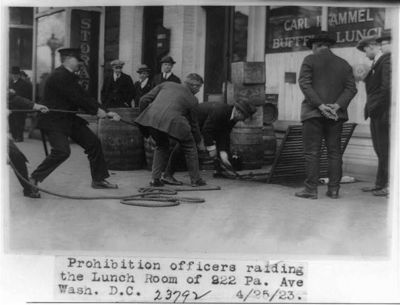Prohibition (United States)
The United States enacted Prohibition of alcoholic beverages through the Eighteenth Amendment of the Constitution and Volstead Act in 1920 during the administration of Woodrow Wilson. During the period, the production, transportation, and distribution of alcohol were banned. The Prohibition was supported by the Temperance Movement, politicians such as William Jennings Bryan, and groups such as Ku Klux Klan. However, during this period a black market of alcohol flourished and violent gangs such as Al Capone's developed. In 1933, the 21st Amendment was ratified and the Prohibition was formally repealed.
Background
The brewing and consumption of alcoholic beverages have a long history in the United States tracing back to the early colonial era. However, in the late 19th century, the alcohol industry greatly expanded due to technological innovation, and establishment serving alcohol, called saloons, proliferated. The social problem of drunkenness soon rose, which caused a great amount of public concern. Organizations like Anti-Saloon League and Woman's Christian Temperance Union emerged to curb alcohol production and consumption. The movement against alcohol was known as the Temperance Movement. Important leaders of this movement include Frances E. Willard, Hannah W. Smith, Cary Nation and Wayne Wheeler.
A political party named Prohibition Party was as a single-issue party specifically advocating prohibition of alcohol was formed in 1869, and still exists as a small party today.
Enactment
The sentiment of temperance soon reached the branches of government of the United States. In 1917, the Congress proposed the Eighteenth Amendment of the Constitution to prohibit alcohol. The amendment was promptly ratified by 45 states in 394 days, and only one state, Rhode Island, voted to reject the amendment.[1]
The Amendment authorized the Congress and states concurrent power to enforce prohibition. In 1919, Congressman Andrew Volstead wrote the National Prohibition Act, known as the Volstead Act, to provide federal enforcement prohibiting the manufacture, transportation, and sales of beverages containing 0.5% or more alcohol.[2]
Implementation
In the early years of Prohibition, alcohol consumption did drop significantly. However, years later it again skyrocketed. Organized crime increased, producing notorious gangsters such as Al Capone of Chicago. The illegal alcohol posed danger to consumers due to its compromised quality, and government revenue decreased due to its inability to tax alcohol. Government corruption also dramatically increased during the Prohibition period. Many drinkers switched to other drugs which were more harmful than alcohol. Some people have compared Prohibition era to nowadays drug prohibition.[3]
Revocation
In the 1930s, the national consensus in United States gradually shifted in favor of the repeal of Prohibition. In 1932, soon after the election of President Franklin Delano Roosevelt, the law was relaxed slightly to allow 3.2% of alcohol content in beer.[4] The Prohibition was formally abolished by the Twenty-first Amendment of the Constitution, proposed in 1933 and ratified by 38 states in 288 days, with only South Carolina voted against ratification.[1] This makes the Eighteenth Amendment the only repealed constitutional amendment in American history.[4]
Sources
Citations
- ↑ 1.0 1.1 Ratification of Constitutional Amendments, The U.S. Constitution Online
- ↑ Volstead Act, Spartacus Educational
- ↑ Mark Thornton, Alcohol Prohibition Was A Failure, CATO Institute, July 17, 1991.
- ↑ 4.0 4.1 Repeal of Prohibition, Prohibition, the "Noble Experiment", April 14, 2005
General references
- Ohio State University College of Humanities, Temperance and Prohibition
- Prohibition Party, Spartacus Educational.
- David J. Hanson, National Prohibition of Alcohol in the U.S.
